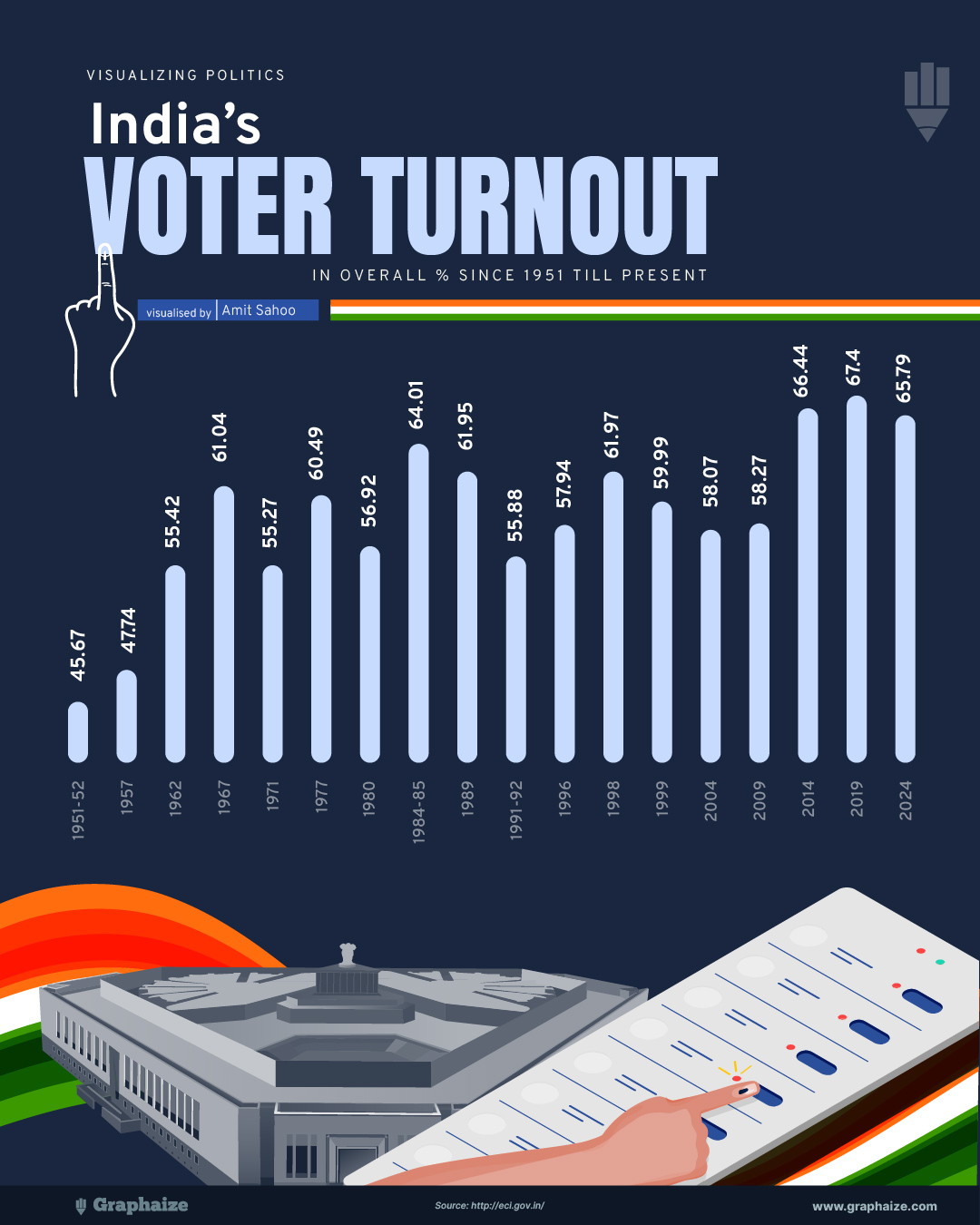
India, the world’s largest democracy, has witnessed a fascinating evolution in voter participation since its first general election in 1951. The journey of India’s voter turnout reflects not only the growing engagement of its citizens in the democratic process but also the shifting political and social landscape of the country. This infographic delves into the trends in voter turnout over the years, examining the key factors influencing these changes and the implications for the future of India’s democracy.
Historical Trends in Voter Turnout
The journey of voter turnout in India began with the 1951-52 general elections, where the turnout was a modest 45.67%. This initial phase was marked by a nascent understanding of democratic processes among the masses, limited access to education, and restricted media outreach. By 1957, the turnout slightly increased to 47.74%, indicating a growing awareness and participation among the electorate.
The subsequent decades saw fluctuating voter turnout rates, with a notable increase in 1962 to 55.42%. This period was characterized by a stabilization of the Indian political landscape and greater political mobilization. However, the turnout saw a decline in the 1971 elections, dipping 55.27%. The 1970s were a period of political turbulence, including the Emergency (1975-77), which likely contributed to the variations in voter turnout.
The Rise in Voter Engagement: 1980s to 2000s
The 1980s marked a significant period in Indian electoral history, with the turnout rising to 56.92% in 1980 and 64.01% in 1984-85. The increase in voter turnout can be attributed to several factors, including the strengthening of electoral institutions, the expansion of media, and the increasing political consciousness among the population. The assassination of Prime Minister Indira Gandhi in 1984 and the subsequent elections were particularly notable for their high voter engagement.
The 1990s continued this trend, with the turnout stabilizing around the 60% mark. The 1989 elections saw a turnout of 61.95%, slightly dropping to 57.94% in 1996. This period was marked by economic liberalization and significant socio-economic changes, which influenced voter behavior. The rise of coalition politics and regional parties also played a crucial role in mobilizing voters from diverse backgrounds.
Participation of millennial voters
The turn of the millennium witnessed a further consolidation of voter participation, with turnout rates generally exceeding 60%. The 2004 elections saw a turnout of 58.07%, which increased to 58.27% in 2009. The 2014 general elections marked a watershed moment with a turnout of 66.44%, the highest in Indian history up to that point. This surge in voter turnout was attributed to several factors, including the rise of social media, extensive voter awareness campaigns, and a vibrant political landscape that resonated with a diverse electorate.
The 2019 general elections continued this trend, with a turnout of 67.4%, reflecting an increasingly engaged electorate. The 2024 elections, although slightly lower at 65.79%, indicate sustained voter participation. The factors driving these trends include the growing youth population, increased political awareness, and the critical role of technology and social media in mobilizing voters.
India’s voter turnout journey from 1951 to the present is a testament to the deepening of democratic values and the increasing engagement of its citizens. While the country has made significant strides, challenges such as voter apathy, misinformation, and logistical issues remain. Addressing these challenges is crucial for sustaining and enhancing India’s democratic fabric.
Unlock the power of captivating visuals with our seasoned expertise! With 7 years of crafting compelling visual content, we’re ready to elevate your brand’s story. From stunning graphics to mesmerizing animations, we bring your vision to life. Let’s create engaging visuals that resonate with your audience and leave a lasting impression. Partner with us today for an unforgettable visual journey!
